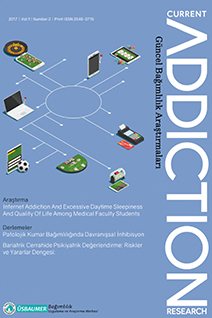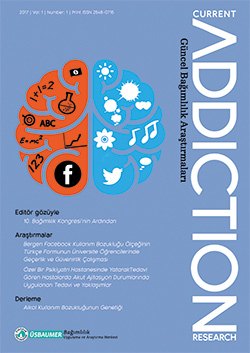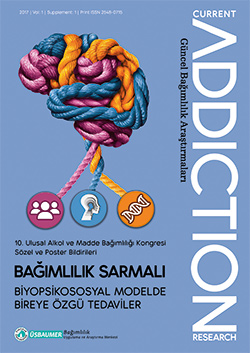Years
2024
Categories
Authors
ARTICLES
Review Article
Substance Addiction In Adolescents And The Role Of The Family: A Mini Review
ÖZKAN EZGİ,KARABURUN MERVE,KABA AYŞE,DURMUŞ ELİF,EMLU HAKAN,KABA FATİH,FİDAN ENİSE KÜBRA
2024, 8(2), s:5-9
Substance addiction is one of the important problems threatening society today. Although it causes negative consequences in the person's life, it makes the process more dangerous as the person develops tolerance and desires the substance more. Adolescence is considered a risky period in substance addiction, where psychological, sociocultural and genetic factors play a role, and many factors such as the biological, psychological and environmental conditions of the adolescent determine the development processes of substance addiction. At this point, the family plays a role in the child's social and cognitive development and is seen as an important factor in the process of developing substance addiction. Lack of family functionality can lead to aggression and anti-social behavior disorder, and as a result, delinquency and substance use behaviors may occur in the adolescent. In this study, the role of the family in adolescents' development of substance addiction will be discussed.
Review Article
A holistic review of fentanyl use and its impact on public health
ALEJANDRO BORREGO-RUIZ
2024, 8(2), s:23-33
Fentanyl is a synthetic opioid that was engineered to provide a potent analgesic effect, with its medical utility widely established in clinical contexts such as pain management and anesthesia. Fentanyl use has become a critical public health issue due to diversion for misuse and to rapidly proliferation of illicit manufacturing. This persistent increase in illicitly manufactured fentanyl distribution shows no indication of decline, raising significant concerns regarding its impact on public health and opioid misuse trends, including a dramatic increase in overdose deaths. Moreover, individuals from socially or economically precarious backgrounds, as well as those suffering from mental health disorders, are particularly vulnerable, as limited access to resources and support systems can lead to increased substance use as a coping mechanism for stress and adversity. Therefore, the objective of this narrative review is to provide a holistic overview on fentanyl, addressing its synthesis process, pharmacology and clinical use, relationship with gut microbiome, epidemiology and global distribution, patterns of use and motivations, and overdose treatment. For this purpose, current and relevant evidence on fentanyl and its correlates has been conscientiously assessed and outlined.
Review Article
Ceyda ŞİŞMAN ÜNLÜ,Cemal Onur NOYAN
2024, 8(1), s:20-27
Gambling Disorder is a clinical picture characterized by repetitive and persistent gambling behavior. Gambling Disorder is the first and only non-substance-related behavioral addiction in the DSM-5 due to its neurobiological and clinical commonalities with alcohol and substance use disorders. When we examine Gambling Disorder from a neurobiological and neurocognitive perspective, neurotransmitters such as dopamine, serotonin, norepinephrine and glutamate are thought to be effective in the development of the disease. From a neurocognitive perspective, Gambling Disorder is based on behavioral conditioning with positive reinforcers, value attribution, impulsivity and impairments in decision-making processes. If an individual adopts gambling behavior as a coping mechanism for negative life events, this behavior continues to increase over time. Increasing gambling behavior over time weakens the individual's self-control capacity and leads to the continuation of gambling behavior despite the negative consequences. This vicious cycle contributes to the exacerbation of the disorder by causing problems in work, family, academic and social areas. Gambling Disorder, although initially a seemingly harmless behavior, can turn into addiction depending on the balance of underlying predisposing and protective factors.
Review Article
Psychology-Related Factors Of Internet Addiction: Literature Review
Eda Deligöz
2024, 8(1), s:28-33



 2. Sayı
2. Sayı
 1. Sayı
1. Sayı
 Ek Sayı
Ek Sayı







